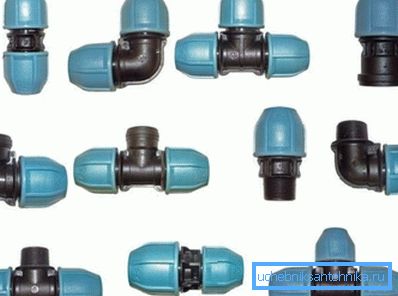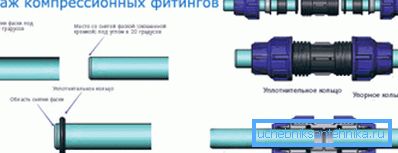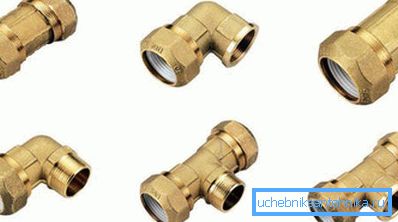Fittings for hdpe pipes: features and methods of use
To date, for transportation along the lines of various substances produced appropriate to the destination pipe. Low-pressure polyethylene serves as a material for the manufacture of multi-purpose pipes. Now the pipe and the PND fittings successfully work both in everyday life and on an industrial scale.

Types of pipes
- Water pressure analogs. Designed to transport water for drinking and technical purposes under pressure.
- Gas pressure pipes. Used for gas mains, as well as for a variety of liquid substances.
- Non-pressure technical products. They are used for laying electrical, telephone and other cables.
Note! In most cases, the material can be easily mounted with your own hands, especially since it is not problematic to buy convenient special fittings. At observance of all rules of fastening will turn out extremely reliable and durable.
Product Specifications

- Depending on the purpose, you can purchase pipes of different outer diameter (16–1200 mm). For example, the number 32 on the product will indicate that you have chosen a pipe with this section.
- The wall thickness varies from 2 mm to 69 mm and depends on the external diameter.
- More thin and flexible pipes are offered to the buyer in coils or coils. Thick can be purchased in lengths up to 12 m.
- The product is supplied with the SDR (Standart Dimension Ratio) marking, which means the ratio of the nominal wall thickness of the pipes to the outer diameter.
- There is a formula for calculating SDR = dn: en.
- It is clear that the price of the purchased product will also depend on the size and quantity of the material spent.
Fittings and their scope
These elements serve the following purposes.
- Connect pipes with the same diameter.
- Pipes with different diameters are joined.
- Installation of turns of highways.
- The instruction also provides for the implementation of various branching systems.
- Pipes can be connected to fittings.
- Easy installation of plugs.
Connectors classification

Pipe connections are distinguished by the following principles.
- By way of installation. There are welded, electrically welded fittings for HDPE pipes, as well as compression.
- By the stiffness of the connection elements are divided into rigid analogues and flexible.
- They can be detachable or non-detachable.
- Straight elements for joining pipes of the same diameter.
- Reducing analogues for connecting pipes of various diameters.
Welded type
Such fittings are manufactured using two basic methods.
- Casting, high pressure (cast).
- Butt welding, from small segments (welded).
- The diameter of the elements is 63–315 mm.
- This type provides installation by means of welding. The range of application causes not only an acceptable cost, but also simplicity and reliability.
Electrowelded type
Electrowelded (thermistor) elements will be useful where the pipeline has to be installed in hard-to-reach areas.
A fitting is completed on connecting places with a special wire. When heated, it melts the pipe, creating a perfectly strong seam.
Compression type

These fittings for HDPE pipes for cold water supply, for the transport of gaseous substances are suitable. Their advantages are that when working does not require equipment for welding, the joints are connected manually.
The end result is a secure fit with the ability to disassemble if necessary.
The fitting consists of the following parts.
- Polyethylene housing.
- Sealing rings at joints.
- Clamping rings to protect the mount from mechanical damage.
- Pressing tube sleeve.
- Nuts caps masking docking seams.
The store offers connecting attachments with a diameter of 16–110 mm.
Threaded connections

When working with a pipeline, this kind of wind on the pipe segments. The material for the manufacture of fittings is cast iron, steel.
Note! Brass fittings for HDPE pipes are also available, popular for their corrosion resistance. This is especially important when conducting plumbing systems.
This species is also divided into several categories.
- Metal products are supplied with a threaded flange or welded joint. When winding on the pipe, it is recommended to use a gasket (FUM tape, special packing or thread).
- Metal products. Have a collet or a combined pair, with the transition collet to the thread-connection. Products with a transitional variant are usually used for joining metal-plastic or metal elements.
Purpose of fittings

Any pipeline system has turns, branchings, connecting nodes of different configurations. Even before installation, it is necessary to purchase not only pipes, but also additions appropriate for the intended purpose and in the right amount.
Here are the categories needed in almost all cases.
- Couplings. By species, they are divided into equal passages (for identical diameters), compensatory (for different diameters) and flange (for large diameters).
- Adapters. They are required to connect to the network of reinforcement or an element from a material other than plastic (for example, metal).
- Clamps They compress the pipe around the circumference, creating the perfect mount.
- Bends. Needed when changing directions of the highway, as well as for cornering.
- Covers. They are used for tapping a new pipe into an already assembled pipeline.
- Stubs Suitable for shutting off gas or liquid if necessary.
- Tees and crosses. Convenient for branching or tapping additional pipes.
Conclusion
Today it is extremely easy to purchase components, as well as get expert advice. It is enough to visit a specialized shop and buy everything you need for work. With the right approach to the question you will not have problems with the installation of the system (see also the article What is Compression Fittings for HDPE pipes - the purpose and scope).
More information can be found in the video in this article.